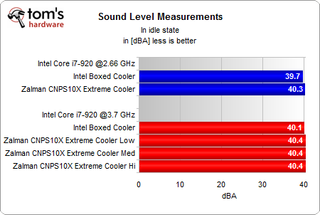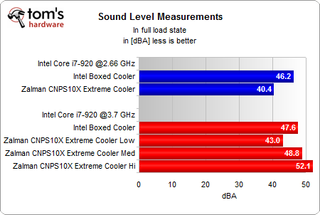Is It Worth Upgrading Your Stock CPU Cooler?
Test Setup And Acoustic Measurements
| System Hardware | |
|---|---|
| Hardware | Details |
| CPU | Intel Core i7-920 (45 nm, 2.66 GHz, 8 MB L2 Cache) |
| Motherboard (Socket 1366) | MSI X58 Pro-E Revision: 1.1, Chipset: Intel X58 + ICH10R, BIOS: 8.3 |
| RAM | 3 x 2 GB DDR3-1600 Corsair TR3X5G1600C8D |
| System Drive | Intel X25-E 64 GB SSD |
| Graphics | Zotac Geforce GTX 260² GPU: Geforce GTX 260 (576 MHz), Graphics RAM: 896 MB DDR3 (1998 MHz) Stream Processors: 216 Shader Clock: 1242 MHz |
| Power Supply | OCZ EliteXstream 800W OCZ800EXS-EU |
| Benchmarks | |
| Performance Measurements | Prime95 v25.5Core Temp 0.99.5 |
| System Software and Drivers | |
| Driver | Details |
| Operating System | Windows Vista Ultimate SP1 |
| Intel Chipset Drivers | Chipset Installation Utility 9.1.0.1007 |
| Intel Storage Drivers | Matrix Storage Drivers 8.7.0.1007 |
Results: Noise Level

We measured the sound level at a distance of 6” (15 cm) on the right side of the cooler, which is why we might be measuring noise closer to the fan than Zalman did when it specified 20-39 dB(A). The noise difference isn’t really significant when the processor is idle, as in that state both coolers are powerful enough to keep temperature under control. For this reason, the fans would not have to spin at high speeds and hence the overall result is quiet operation.

Things are different at full processor load. While the Zalman cooler is efficient enough to spin at slow rotation speeds (even though the Core i7-920 runs at peak load at 2.66 GHz), Intel’s boxed cooler becomes noisy as it rises from 39.7 to 46.2 dB(A), and it gets even noisier when cooling the same processor running 3.7 GHz.
Zalman’s CNPS 10X would make more noise than the Intel retail cooler at its medium or high fan speed settings, but it is capable of significantly more effective temperature reduction. Check out the next page for the temperature results.
Stay on the Cutting Edge
Join the experts who read Tom's Hardware for the inside track on enthusiast PC tech news — and have for over 25 years. We'll send breaking news and in-depth reviews of CPUs, GPUs, AI, maker hardware and more straight to your inbox.
Current page: Test Setup And Acoustic Measurements
Prev Page Intel's Core i7-920 And A Replacement Cooler: Zalman's CNPS 10X Extreme Next Page Benchmark Results: Core TemperatureMost Popular

